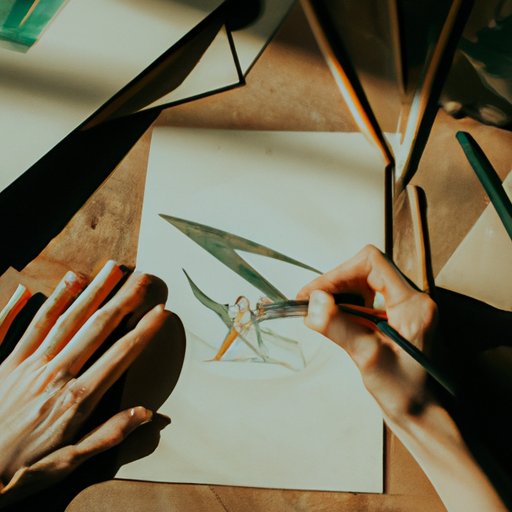
I. Introduction
Are you a beginner looking to start your artistic journey? Drawing is a great place to start! Not only is it a wonderful form of self-expression and creativity, but it also provides a sense of accomplishment and is a great stress-reliever. However, starting to draw can be intimidating, especially if you have no prior experience. But fear not, with this comprehensive guide, we will explore the 5 steps to drawing for beginners, basic drawing techniques, how to overcome the fear of drawing, creating your first masterpiece, and what drawing tools and supplies to use as a beginner.
II. 5 Steps to Drawing for Beginners
Whether you want to draw realistic portraits or cartoon characters, the following steps are the building blocks of any drawing:
Step 1: Choosing your subject
The first step in drawing is to choose your subject. It can be anything that inspires you, like a beautiful landscape or a family member’s portrait. Choose a subject that excites you and makes you want to draw.
Step 2: Outlining the basic shapes
Once you have chosen your subject, start by outlining the basic shapes. Simplify the subject into basic shapes, making it easier to draw. For example, if you want to draw a human face, start with an oval for the head and add circles for the eyes, nose, and mouth.
Step 3: Adding details and textures
Once the basic shapes have been outlined, it’s time to add details and textures. Pay attention to the details of the subject, like the wrinkles on someone’s face or the texture of tree bark. These details bring the subject to life.
Step 4: Shading to create depth and dimension
Shading adds depth and dimension to the drawing. Start by identifying the light source and adding shadows to the subject where the light doesn’t reach. Practice the different shading techniques like cross-hatching, stippling, and blending.
Step 5: Adding the finishing touches
Once you are satisfied with the drawing, add the finishing touches, like highlights and fine details. These small additions make the drawing pop and gives it a professional feel.
III. Basic Drawing Techniques for Beginners
Here are some basic drawing techniques that every beginner should explore:
Contour drawing
A contour drawing is a continuous line drawing that outlines the subject. Unlike other drawing styles, contour drawing teaches the artist to see the subject as a series of continuous lines and shapes.
Cross-hatching
Cross-hatching is a technique used in shading. It involves drawing a series of parallel lines and then crossing over them with more parallel lines at an angle, creating a cross-hatched pattern.
Blending
Blending involves using a tool like a tortillon or your finger to smooth out the lines and blends the shading together into a more cohesive look.
Stippling
Stippling is a technique where the artist creates textures and shading by using a series of small dots or dashes.
IV. Overcoming the Fear of Drawing: Tips for Beginners
Here are some tips for beginners to overcome their fear of drawing:
Starting with simple shapes
Start by drawing simple shapes and work your way up to more complex subjects. This way, you won’t feel overwhelmed and can learn at your own pace.
Focusing on the process, not the end result
Don’t worry about the final product, enjoy the process of drawing. Embrace your mistakes, learning from them, and enjoy the journey.
Practicing regularly
The more you practice, the better you get. Set aside time each day to practice and improve your skills.
Embracing mistakes
Mistakes are an essential part of learning how to draw. Don’t let them discourage you, instead, embrace them, learn from them, and keep practicing.
V. Creating Your First Masterpiece: A Guide for Beginner Artists
Creating your first masterpiece is an exciting experience, and here’s how to do it:
Choosing a subject that sparks inspiration
Choose a subject that excites you and makes you want to draw. This will make the process more enjoyable, and you will be more motivated to finish the artwork.
Breaking the subject down into basic shapes
Start by outlining the basic shapes of the subject, then add details and textures. Follow the 5-step process mentioned above.
Using shading to create depth and dimension
Shading adds depth and dimension to the drawing, making it more realistic. Practice the different shading techniques mentioned earlier.
Adding personal flair to make the artwork unique
Add your personal flair to the artwork. This can include your signature style or touches that make the artwork unique to you.
VI. Drawing Tools and Supplies: What to Use for Beginners
Here are some recommended drawing tools and supplies for beginners:
Pencils
Get a set of high-quality drawing pencils, ranging from hard to soft leads. These pencils allow for a range of shading and textures.
Erasers
Get a kneaded eraser that can be shaped to fit the needs of the drawing. Also, get a regular eraser for cleaning up small mistakes.
Paper
Get high-quality drawing paper that can handle heavy shading and is acid-free, minimizing yellowing over time.
Sketchbooks
Get a sketchbook to keep all your drawings in one place. It’s also a great way to see the progress and development of your skills over time.
Other optional tools and supplies
Some other optional tools and supplies include a drawing board, blending stumps, fixative, and rulers.
VII. Conclusion
Now that you have this comprehensive guide, you can start your artistic journey with confidence. Remember, drawing is a form of self-expression and creativity, so don’t be too hard on yourself if you make mistakes. Practice regularly, and you will see significant improvements over time.




